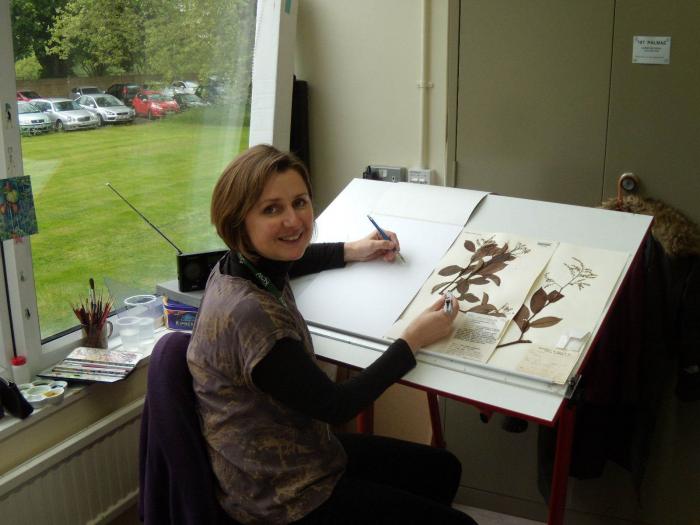Meet Lucy T Smith, award-winning botanical illustrator
Kew has never had a day without a botanical illustrator translating the discoveries found by plant hunters. Lucy T Smith talks about her work.

Friends and colleagues of the artist Lucy Smith were recently delighted to learn that she had won second prize in the Margaret Flockton award for botanical illustration – in fact, the third time she has received the second prize in this prestigious award. Lucy’s winning illustration of the rare Madagascan grass Lecomtella madagscariensis was prepared for Kew grass specialist Dr. Vorontsova. I was lucky enough to catch up with Lucy, during a recent break in her work in the Herbarium at Kew, and learn a little more about her approach to illustration.

Lucy is one of a number of highly skilled freelance botanical illustrators working at Kew to produce line drawings for scientific plant publications. Lucy is much in awe of her colleagues, and praises the Flockton award for bringing together the work of international artists. Its emphasis on accurate depiction of plant characters, technical and artistic merit, composition, and reproducibility all serve to highlight the rigorous requirements demanded of a scientific line drawing.
Production of line drawings is driven by two main purposes: to contribute to floras of existing plants, and to document new species. Lucy says that she feels a great responsibility to ensure that all her line work is correct, as her illustration will be used to identify the plant it describes. Artists tend to work from dried specimens or specimens stored in spirit for line drawings, but use a live specimen when illustrating in colour. Lucy is adept at both line and colour work and describes how useful it is to produce these two works in tandem in order to inform each other.
Most illustrators specialise in illustrating one or a small number of plant families and Lucy first came to Kew to illustrate palms, an area in which she continues to focus her work. She shows me some examples of dried palm specimens – their leaves folded in half or thirds for storage. These specimens are too brittle to unfold and so the artist re-imagines the specimen by measuring each part of the palm leaf and then uses this information to draw it to a smaller scale in its entirety
Lucy shows me her meticulously kept sketchbooks where she works out her initial drawings and layout. She uses a camera lucida attached to a microscope to draw some of the most minute specimens. I get to try this out with some tiny grass seeds and soon realise how long it must take to master this technique – it is very hard to look down the microscope and draw the outline of the specimen without looking at my hand and the pencil! After making initial sketches Lucy will then consult with the botanist for whom she is illustrating in order to determine which parts of the plant should be included and to get approval of the accuracy of her work. Once the elements of the drawing have been decided she then lays them out on the page in a logical order with the main specimen in the middle and details such as habit, vegetative details, and illustrations of flower and fruit carefully placed around it. She then inks over the top of her pencil work with a very fine pen using fine stippling to mould form. Lucy’s illustrations are aesthetically beautiful but she emphasises that they are science led and that the main consideration is accuracy and care to include enough information without cluttering the drawing with unnecessary detail. It is to her credit that she is able to create both a scientifically accurate illustration and visually stunning work.
Lucy’s enthusiasm for her work is palpable and she describes her excitement at bearing witness to some of the first instances of the naming of a new species by Kew botanists. She recalls the recently identified palm Tahina spectabilis of which she made illustrations – the first specimen was dissected in front of her eyes for her to draw with the added pressure that it was the only material from this plant available at the time.
I look forward to seeing more work by Lucy and her colleagues and, as well as continuing to appreciate the line work for its scientific and artistic value, I will remember to consider the painstaking process and careful technique that has been invested in one of these incredibly detailed works.
- Julia -